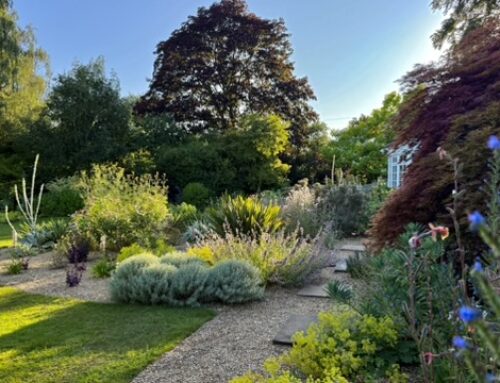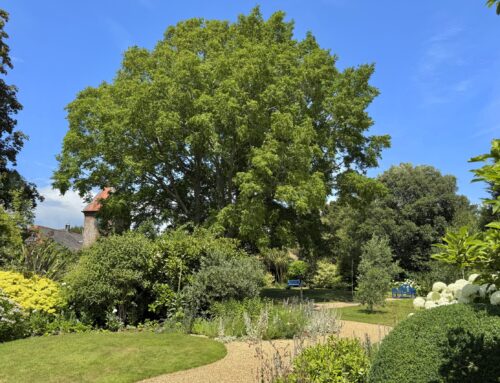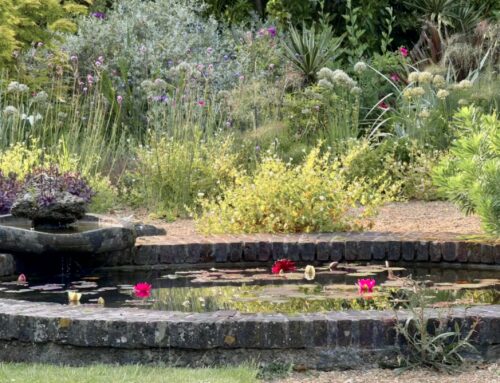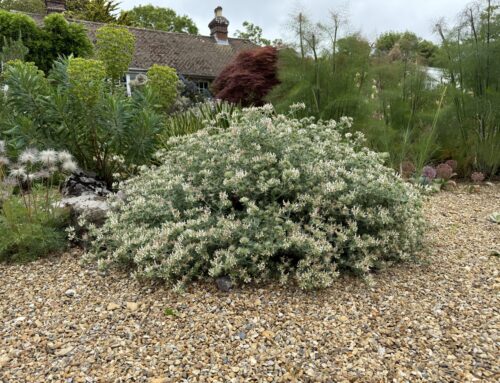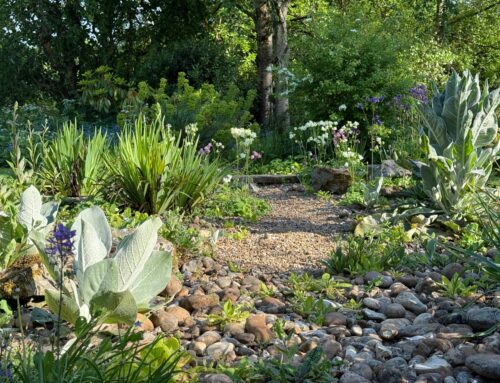An Interview with Oscar Romp, Figurative Artist and Denmans Garden Artist-in-Residence 2024
The internationally renowned British landscape designer, John Brookes MBE, moved to Denmans Garden in 1980. A Modernist greatly influenced by painters such as Piet Mondrian and Ben Nicholson, John saw gardens as collages of shapes and likened creating a garden to creating sculpture. For him, the natural materials of ‘art in nature’ were the basic materials with which landscape designers work.
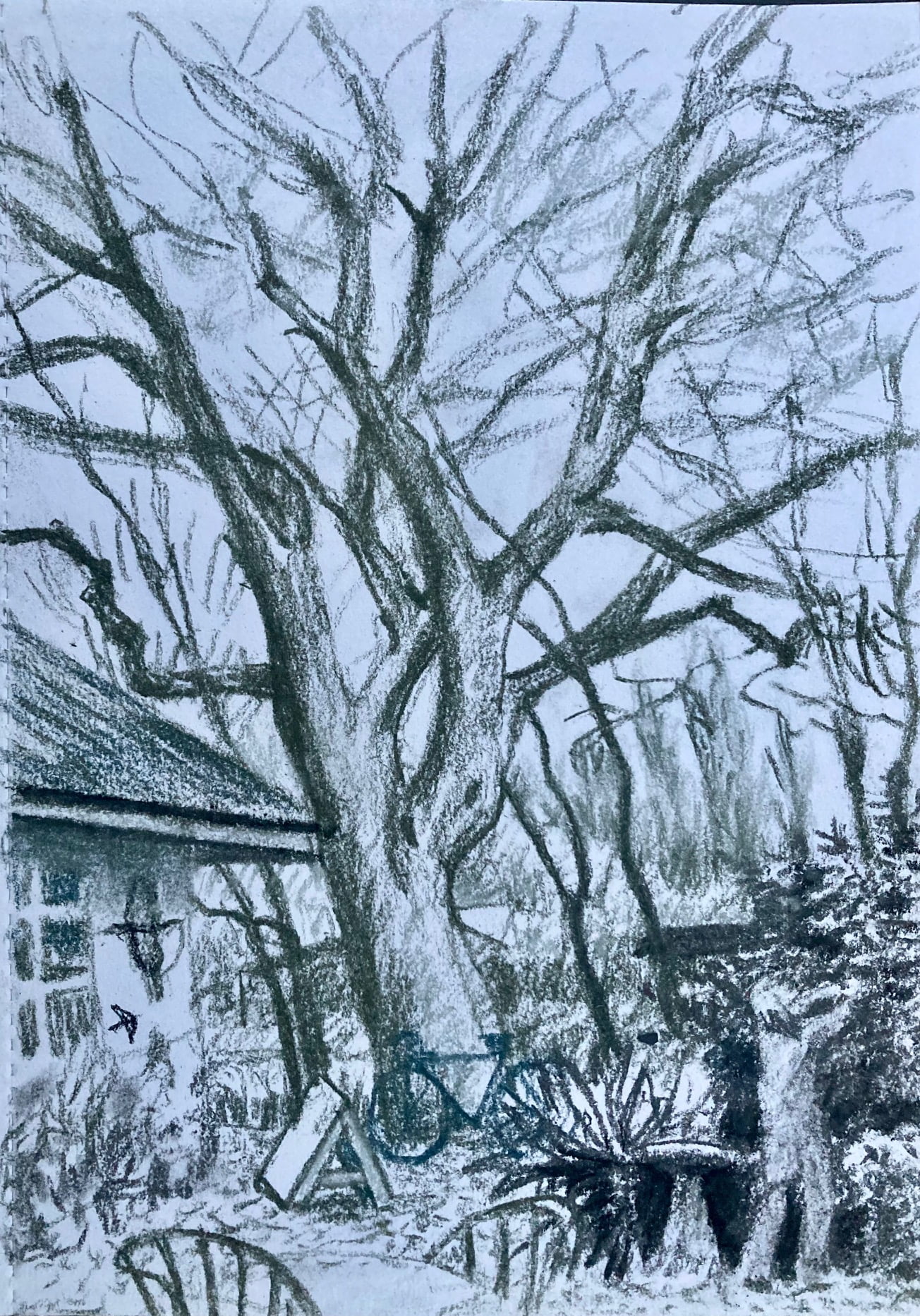
Inspired by John’s vision, Denmans Garden launched an Artist-in-Residence programme in 2021, an opportunity for a specific artist to explore and express their relationship with the garden.
We are delighted to announce that figurative artist Oscar Romp will be our third Artist-in-Residence. He follows landscape artist Sue England and watercolourist Jo Dowers. Currently Sussex–based, Oscar has worked across the UK and internationally as a commissioned site-specific artist, painter and illustrator with UK clients including Kings College Hospital NHS Trust and The National Trust.
He began working at Denmans at the end of last year, creating some initial impressions, as you will see here. Like Sue and Jo, Oscar will give insights and progress updates throughout the year on his website (here) as well as seasonal quarterly updates for the Denmans blog.
Here we kick his residency off with an interview talking to Oscar about his initial thoughts on the residency and his hopes for the year ahead in making his own interpretation of Denmans Garden.
Denmans Garden collaborates in a variety of ways with local artists and makers, be that through hosting events and workshops, showcasing work in the gift shop and garden or through providing inspiration and materials. Over the past three years we have interviewed some of them to find out more about their work and inspiration. Please see our News & Blog page here.
OSCAR: Gwendolyn had initially invited a mutual friend Andrew Churchill to be the next artist in residence at Denmans, not knowing that he had recently relocated to Northern Ireland. Not only is Andrew an excellent painter, he is also an experienced and visionary curator. He was responsible for the selection and curation of the highly successful joint exhibition I shared with my Mum and Dad entitled ‘The Romps Of Bognor’, in October 2022 at Oxmarket Contemporary Gallery. When asked if he knew of any other suitable artists, Andrew put forward my name.
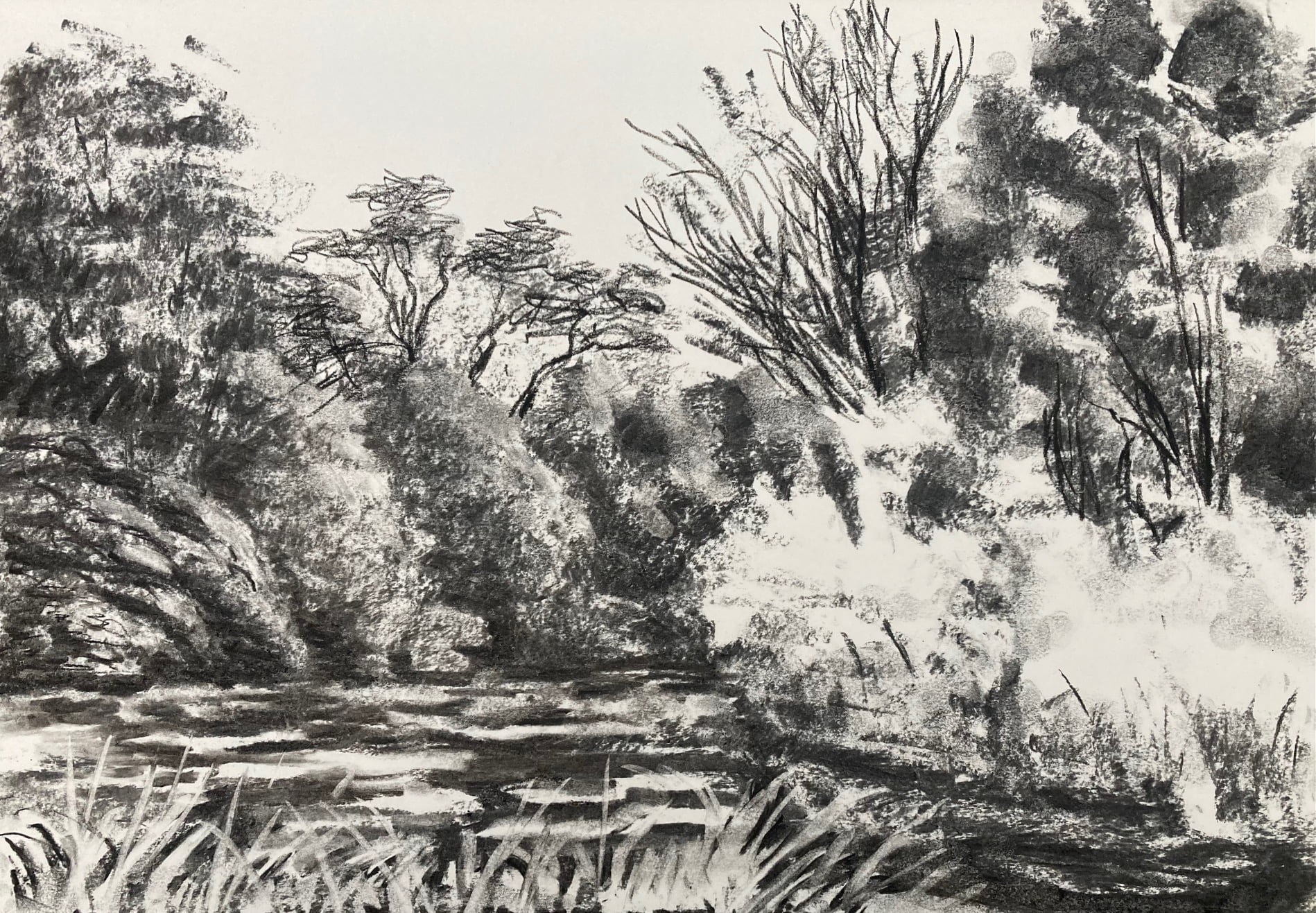 I think for me, at this early stage, what most impresses and sticks in my mind about Denmans is the landscaped motif of the winding dry river bed which lures the visitor on an ever-changing pathway around corners and through trees and shrubs. The shapes of the path and surrounding shrubs are mostly curves but are punctuated by more spikey or jagged trees and shrubs. The garden is purposefully designed yet also has elements of random ‘wildness’. It’s far from the geometric symmetry that you find a feature in many parks and gardens since the times of Louis 14th’s Versailles. My mother’s garden also has this feeling; that of nature being steered but not tamed.
I think for me, at this early stage, what most impresses and sticks in my mind about Denmans is the landscaped motif of the winding dry river bed which lures the visitor on an ever-changing pathway around corners and through trees and shrubs. The shapes of the path and surrounding shrubs are mostly curves but are punctuated by more spikey or jagged trees and shrubs. The garden is purposefully designed yet also has elements of random ‘wildness’. It’s far from the geometric symmetry that you find a feature in many parks and gardens since the times of Louis 14th’s Versailles. My mother’s garden also has this feeling; that of nature being steered but not tamed.
When I first arrived to draw onsite, in November, the garden was here-and-there aflame with vibrant oranges, reds and browns, (even though this aspect was probably less than usual due to the late arrival of autumn and turning leaves this year). My first drawing attempts to reflect this autumnal dazzle. On a cold winter’s day, now the leaves are off most of the trees, it is the patterns, tones and textures of the garden which grab me. My subsequent drawings have thus so far been monochrome and almost absent of colour.
 I’m known for my ‘clubscape’ drawings and paintings of Northern Soul, Funk, House and Jazz-dance club events where I draw live on location in real time, focussing on the vibe and elan of the event, as much as the interaction and movement of figures in the form of dancers, DJ’s, musicians and spectators. Being a dancer, music-lover and DJ myself, I work from the viewpoint of a committed participant, not only as an observer.
I’m known for my ‘clubscape’ drawings and paintings of Northern Soul, Funk, House and Jazz-dance club events where I draw live on location in real time, focussing on the vibe and elan of the event, as much as the interaction and movement of figures in the form of dancers, DJ’s, musicians and spectators. Being a dancer, music-lover and DJ myself, I work from the viewpoint of a committed participant, not only as an observer.
My starting point always comes from being there, working live at the place, in the moment. You can see the energy and excitement in the initial marks I make in the first stage of working live on site. And the later ‘post-production’ stage is an attempt to focus and go deeper, without actually obliterating that initial excitement of confronting a subject and pulling out from it a pictorial motif. It is a kind of balancing act, involving some risk, as you might end up destroying the qualities of those first marks and initial encounter with the subject.
On a ‘good day’ the drawing/painting works so well with that initial onsite encounter, that to ‘add’ would only ‘subtract’ from the picture. But usually, my first attempts are sketchy and inaccurate. They are not articulating what I want to say clearly enough. I work mostly in charcoal and pastel, because of the flexibility of these media. It is quick and easy to push this coloured dust around on the paper surface, to easily erase and redraw, so that you can pull-out a stronger image. It can be as much about taking material away with a rag or putty rubber, as it is about putting material on with a stick of charcoal or pastel.
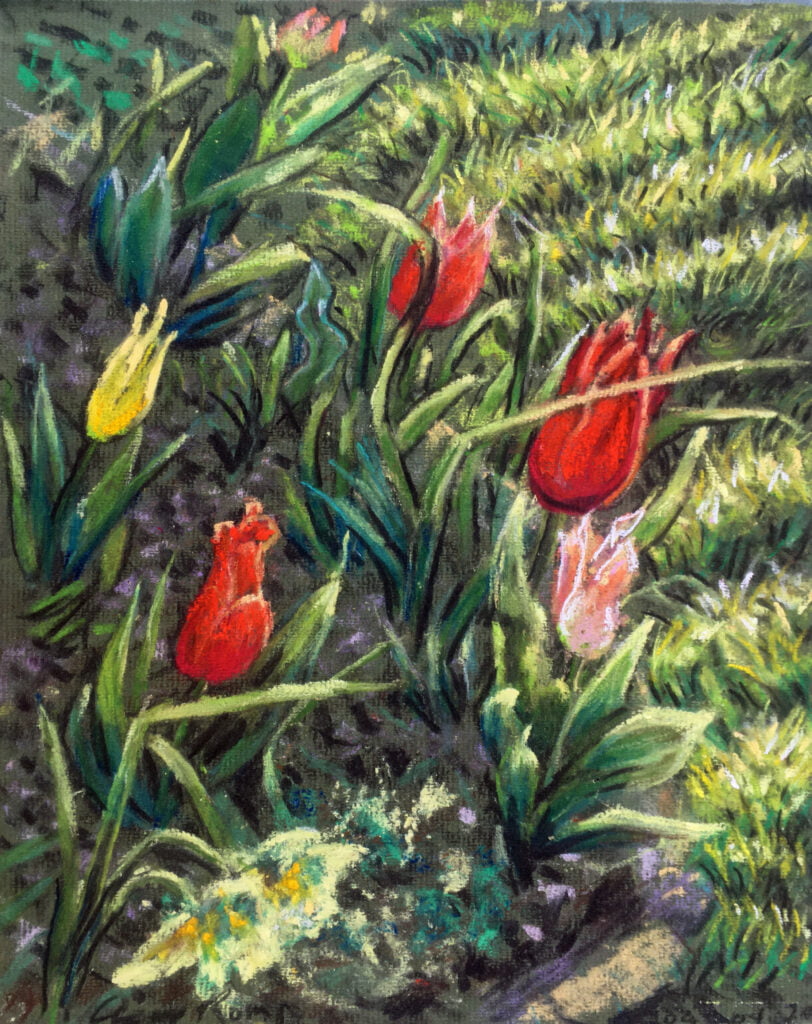 I’ve learnt through practice that oil paint has a similar flexibility and can be easily pushed around and moulded. Time is on your side, in that it takes so long to dry, and you have ample chances to add, subtract marks or make changes. But it is not as direct as charcoal and pastel, with so much more preparation required…squeezing colour from tubes onto a palette, mixing a set of colours on the palette, manoeuvring the paint from palette onto the brush, adding a solvent or medium for fluidity or transparency, and then (finally) getting the paint off the brush and onto your picture surface, where you can rework it at will…It’s a lot of ‘monkey-business’ which can make it easy to lose momentum. But if you can keep your focus, the results are persuasive and permanent.
I’ve learnt through practice that oil paint has a similar flexibility and can be easily pushed around and moulded. Time is on your side, in that it takes so long to dry, and you have ample chances to add, subtract marks or make changes. But it is not as direct as charcoal and pastel, with so much more preparation required…squeezing colour from tubes onto a palette, mixing a set of colours on the palette, manoeuvring the paint from palette onto the brush, adding a solvent or medium for fluidity or transparency, and then (finally) getting the paint off the brush and onto your picture surface, where you can rework it at will…It’s a lot of ‘monkey-business’ which can make it easy to lose momentum. But if you can keep your focus, the results are persuasive and permanent.
Usually, once I’ve got the initial motif from working live onsite, I may retreat to a studio space, to work into the image, often focussing the tonal range of light and dark, and heightening or balancing the colour values in a kind of ‘post-production/remix process’. ‘Getting away’ from the subject can be as important as ‘being in front of’ the subject. The bewildering complexity of Reality can be overwhelming… Any form of picture-making is about selecting-out from chaos the most striking aspects from what the eye can indiscriminately see, in order to present your own special and human vision’. It can therefore be just as useful to ‘get away from’ the subject, as it is to stand, look and draw in front of it.
I should hope that some of these concerns are able to sneak into my Denmans artworks, – and is more likely to do so if I selectively introduce figures into the ‘gardenscape’ (be they humans or birdlife). Gwendolyn had the excellent idea that I could ‘shadow’ the gardeners and volunteer teams when they are at work and make images of them in action as they shape and fashion the garden.
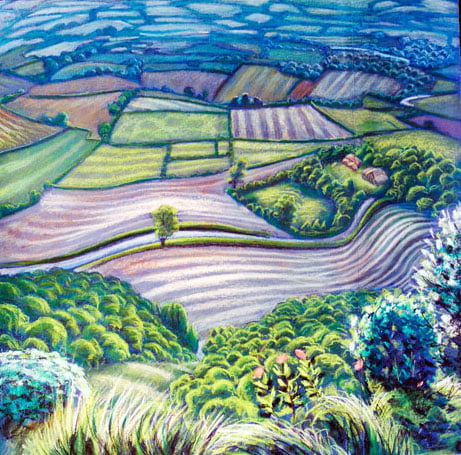
© Oscar Romp
http://www.oscarromp.co.uk
My enjoyment of drawing dancers extends to an enjoyment of drawing humans engaged in any sort of activity. As a student I found long hours of trying to draw some naked person slumped on a couch quite boring. It got interesting when we were asked to do quick 5-minute drawings of short dynamic poses, or of the model in an activity such as sweeping the floor with a broom. I find the human body is far more engaging and revealing when clothed rather than unclothed.
Thinking about shape, form and texture are very musical concerns. The rhythm in a dance music record is like the patterns made across a ploughed field or made by the repeated shapes of a hedge snaking across the same field.
My initial drawings and choice of subject are purely instinctive – whatever grabs me at the moment of arrival, after cycling to Denmans from Bognor…I find that with any new project, it is better to jump in at the deep end and just get working, rather than ask too many questions and stare at a blank canvas…Its a method of ’shoot first, ask questions later’….Often the ‘live’ drawings and sketches may be ’tweaked’ or totally re-worked later in the studio. Or new, related works are made with reference to additional sketches and photographic iPhone snaps.
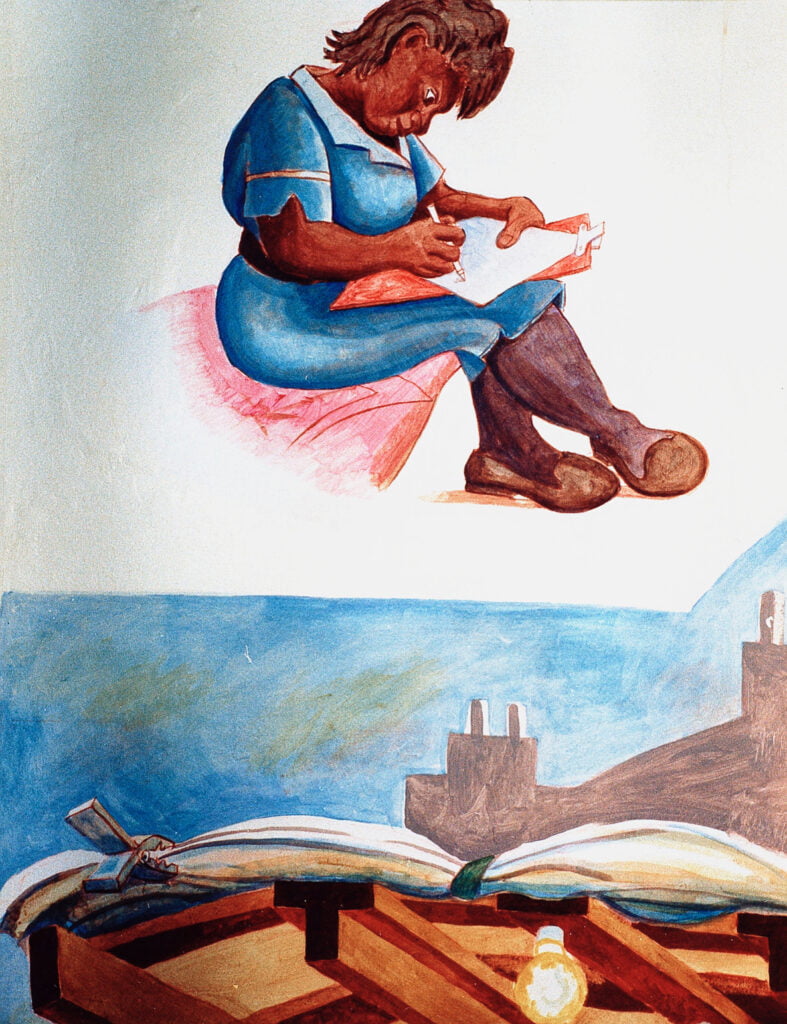 There is a tendency in our culture to ‘pigeon-hole’ people as either one thing or the other. People are cast as ‘black’ or ‘white’ rather than revealing their true complexity and ‘grayscale’. There is always pressure to specialise, which can minimise or deny other sensibilities and possibilities. I’m best known as a painter of clubs and dancefloors, but these may not necessarily be my best works. The Denman’s Residency offers me the opportunity to ‘break out of the box’, to work in a different place and context; a place which already has a strong identity.
There is a tendency in our culture to ‘pigeon-hole’ people as either one thing or the other. People are cast as ‘black’ or ‘white’ rather than revealing their true complexity and ‘grayscale’. There is always pressure to specialise, which can minimise or deny other sensibilities and possibilities. I’m best known as a painter of clubs and dancefloors, but these may not necessarily be my best works. The Denman’s Residency offers me the opportunity to ‘break out of the box’, to work in a different place and context; a place which already has a strong identity.
So far, it has been a challenge to make ‘live’ outdoor drawings in the winter weather during an exceptionally wet autumn and winter. You have to get something down on paper quick, before the next shower comes, and before your fingers and toes go numb. I have my methods for keeping warm against the cold, with a constant flask of cinnamon tea on the go and additional layers of clothing and waterproofs when needed!
The main thing the residency offers is that it gives me the staff, volunteers, and the visiting public to interact and work with. I dislike working completely alone and in isolation. I need discourse to bounce-off from. I won’t be too prescriptive, trying to predict in what direction the work may flow. I prefer to let it take its own course from the process of looking, imagining and doing.
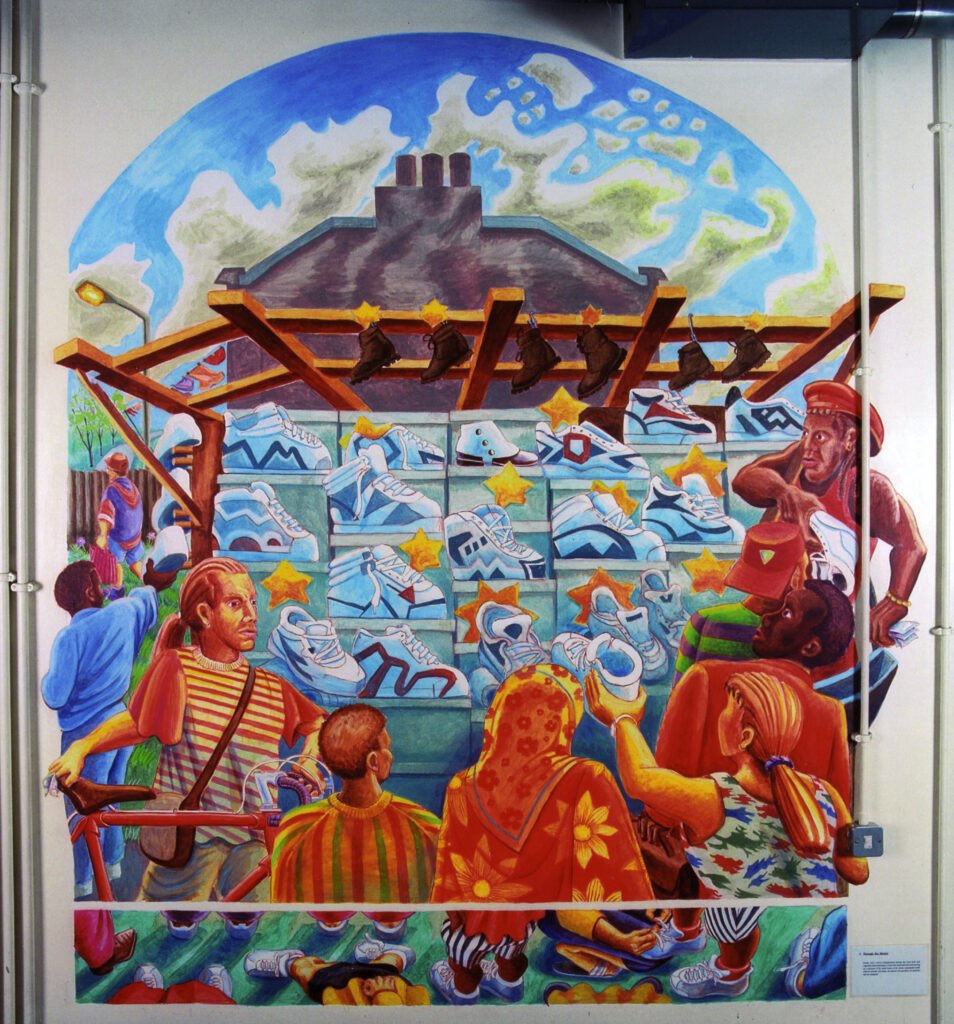 I’ve recently been revisiting the intricate works of 18th century landscape printmaker and naturalist Thomas Bewick. He wrote and illustrated the first ever bird-identification book, as well as illustrating numerous novels and children’s books. Of particular interest are his ‘Vignettes’. These are little woodblock prints designed to illustrate the beginnings and ends of chapters in any given book. What’s unique and appropriate about them is that they are pictures without an edge. Usually oval or rounded in shape, they bleed out into the empty page rather than being constricted by the hard, unnatural rectangular edges of a page or canvas. Many years ago, I took a similar approach to designing mural panels for the series I did for Kings College Hospital, London (1994-7). The large rectangular murals expanding across walls of 20 or more feet in length, would be punctuated by much smaller ‘inbetweenie’ panels which would be round, oval, or bleed into the wall without an edge at all. It might be good to re-inhabit this way of working at Denmans, as, like nature itself, the garden does not have square edges.
I’ve recently been revisiting the intricate works of 18th century landscape printmaker and naturalist Thomas Bewick. He wrote and illustrated the first ever bird-identification book, as well as illustrating numerous novels and children’s books. Of particular interest are his ‘Vignettes’. These are little woodblock prints designed to illustrate the beginnings and ends of chapters in any given book. What’s unique and appropriate about them is that they are pictures without an edge. Usually oval or rounded in shape, they bleed out into the empty page rather than being constricted by the hard, unnatural rectangular edges of a page or canvas. Many years ago, I took a similar approach to designing mural panels for the series I did for Kings College Hospital, London (1994-7). The large rectangular murals expanding across walls of 20 or more feet in length, would be punctuated by much smaller ‘inbetweenie’ panels which would be round, oval, or bleed into the wall without an edge at all. It might be good to re-inhabit this way of working at Denmans, as, like nature itself, the garden does not have square edges.
For more about the Denmans Garden/Artist-i- Residence collaboration go to (link to the press release)
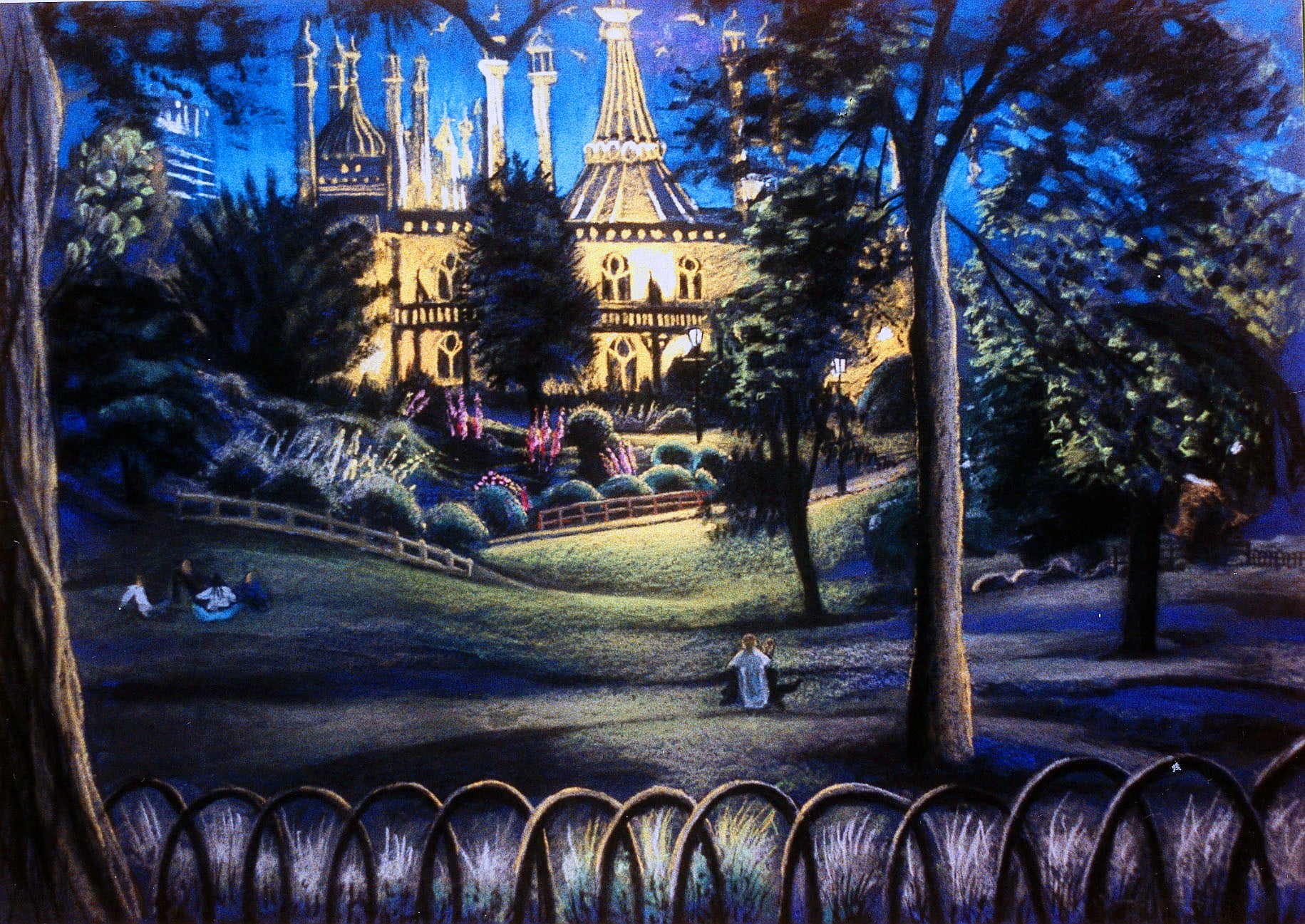
Oscar Romp will be recording his experiences and observations on his own website and social media and Denmans will include updates on the garden’s website blog as the year goes on.
For more information on Oscar go to https://www.oscarromp.co.uk/
@oscarromp
For more information, please contact Louise Campbell
louise@denmans.org 07540892364
@denmans_garden
www.denmans.org


